| D.IV | |
|---|---|
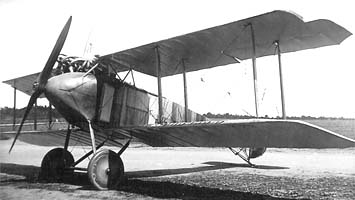 | |
| Role | Fighter |
| Manufacturer | Fokker |
| Designer | Martin Kreutzer |
| Introduction | 1916 [1] |
| Primary users | German Army Swedish Air Force |
| Number built | 44 |
The Fokker D.IV was a German fighter biplane of World War I, a development of the D.I. [2] [3]
| D.IV | |
|---|---|
 | |
| Role | Fighter |
| Manufacturer | Fokker |
| Designer | Martin Kreutzer |
| Introduction | 1916 [1] |
| Primary users | German Army Swedish Air Force |
| Number built | 44 |
The Fokker D.IV was a German fighter biplane of World War I, a development of the D.I. [2] [3]
The Fokker D.IV had a more powerful Mercedes D.III engine, and was the first Fokker front-line design to use ailerons in place of wing warping from the start for roll control. [4]
The aircraft was purchased in small numbers (40) by the German Army but it is thought that only 1 aircraft flown by Hans von Keudell of Jasta 1 saw any service on the Western Front all others being relegated to a training role or home defense duties. This was because of a general ban placed on the front-line use of Fokker aircraft on 6 December 1916 due to poor workmanship and a lack of quality control at the factory.
The Swedish Air Force also bought four examples of the type powered by 150 h.p. Benz Bz.III engines., [1] [5] but only 1 was assembled and armed, the remaining 3 being stored in a dismantled state.
General characteristics
Performance
Armament

The Fokker D.VII was a German World War I fighter aircraft designed by Reinhold Platz of the Fokker-Flugzeugwerke. Germany produced around 3,300 D.VII aircraft in the second half of 1918. In service with the Luftstreitkräfte, the D.VII quickly proved itself to be a formidable aircraft. The Armistice ending the war specifically required, as the fourth clause of the "Clauses Relating to the Western Front", that Germany was required to surrender all D.VIIs to the Allies. Surviving aircraft saw much service with many countries in the years after World War I.
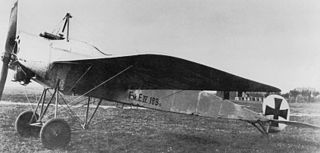
The Fokker E.IV was the final variant of the Eindecker fighter aircraft that was operated by Germany during World War I.

The Siemens-Schuckert D.IV was a late-World War I fighter aircraft from Siemens-Schuckert (SSW). It reached service too late and was produced in too few numbers to have any effect on the war effort.
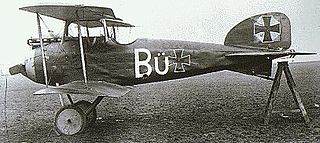
The Albatros D.I was a German fighter aircraft used during World War I. Although its operational career was short, it was the first of the Albatros D types which equipped the bulk of the German and Austrian fighter squadrons (Jagdstaffeln) for the last two years of the war.

The Fokker D.I was a development of the D.II fighter. The D.I was also flown in Austro-Hungarian service as a fighter trainer aircraft under the designation B.III. Confusing the matter further, both the D.II and D.I arrived at the Front in German service at similar times, in July–August 1916. The main designer was Martin Kreutzer.

The Albatros D.XII was a German single-seat fighter biplane first flown in March 1918. It was the last of the Albatros fighters completed and flown before the end of World War I and had the same slab-sided fuselage seen on the Albatros D.X.

The Halberstadt D.II was a biplane fighter aircraft developed and manufactured by German aircraft company Halberstädter Flugzeugwerke.

The LFG Roland C.II, usually known as the Walfisch (Whale), was an advanced German reconnaissance aircraft of World War I. It was manufactured by Luft-Fahrzeug-Gesellschaft G.m.b.H.

The Pfalz D.VIII was a German World War I fighter aircraft.
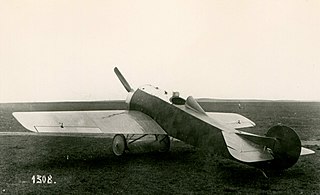
The Fokker V.17 and its derivatives were a series of experimental monoplane Fighter aircraft produced by the Dutch aircraft company Fokker in the 1910s.

The Fokker D.III was a German single-seat fighter aircraft of World War I. It saw limited frontline service before being withdrawn from combat in December 1916.
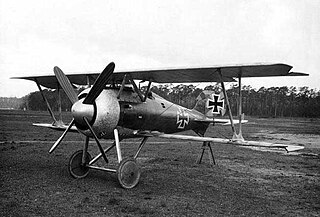
The Siemens-Schuckert D.III was a German single-seat fighter built by Siemens-Schuckert Werke. The D.III was a development of the earlier Siemens-Schuckert D.IIc prototype. The D.III was an (nearly) equal-span biplane powered by a 160 hp (119 kW) Siemens-Halske Sh.III bi-rotary engine. Idflieg placed an order for 20 aircraft in December 1917, followed by a second order of 30 aircraft in February 1918.

The Roland D.VI was a German fighter aircraft built at the end of World War I. It lost a fly-off to the Fokker D.VII, but production went ahead anyway as insurance against problems with the Fokker.

The LFG Roland D.II was a German single-seat fighter of World War I. The type was manufactured by Luftfahrzeug Gesellschaft, and also by Pfalz Flugzeugwerke under license.
The Schütte-Lanz D.IV was a German fighter prototype during World War I. It was developed in parallel with the Schütte-Lanz D.III, however the two fighters had nothing in common. The D.IV was made of wood and was a single-bay staggered biplane with N-type interplane struts and ailerons on both upper and lower mainplanes. It first flew in late 1917 and was found to be inferior to the Schütte-Lanz D.III, and as a result production was not started.

The LFG Roland D.III was a fighter aircraft produced in Germany during World War I.

The Fokker D.IX was a Dutch single seat, single engine fighter aircraft, the final, more powerful evolution of the Fokker D.VII World War I success, flown in 1921. The sole example was purchased by the US Army Air Service but not developed further.

The Kondor D 7 was a prototype German single seat biplane fighter built over the winter of 1917-18. It was not a success and its development was soon abandoned.

The Friedrichshafen D.I was a German single-seat fighter plane developed by the Flugzeugbau Friedrichshafen during the First World War. Two prototypes were flown in 1917, but it was judged inferior to the Albatros D.III then in production and no further production ensued.
The BFW CL.I was a prototype German escort fighter aircraft of World War I.
Notes
Bibliography